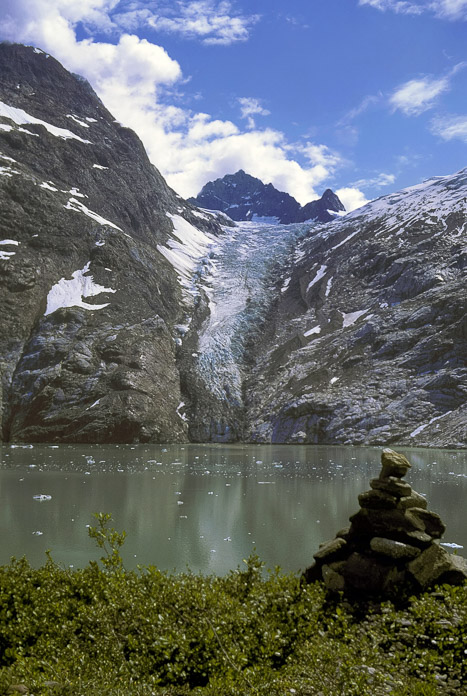
ジョンズ・ホプキンス入り江(Johns Hopkins Inlet)の向こうに見えるカショト(Kashoto)氷河。1967年7月14日撮影。ビル・フィールド(Bill Field)博士はグレーシャーベイ(Glacier Bay)国立公園で見晴らしの利く場所を写真撮影用に設定し、1925年から60年以上を掛けて公園一体の氷河の活動を記録しました。公園の氷河の変動の様子が正確にわかるのは誰にも増してフィールド博士のお陰です。博士の丹念な記録がその後の氷河学、生物学の基礎となり、やがてグレーシャーベイ国立公園が知られるようになりました。写真手前に積まれた岩は「第九写真撮影所」です。
这是1967年7月14日从Johns Hopkins Inlet(约翰斯·霍普金斯湾)到Kashoto Glacier(卡守托冰川)的景色。从1925年开始,在60年多年的时间里,Dr. Bill Field(比尔·菲儿德博士) 一直通过一系列位于关键位置的摄影站准确地记录了整个Glacier Bay(冰川湾)的冰川活动。对我们关于公园里冰的活动的精确认识,菲儿德博士做的贡献比其他任何人的都大。他的耐心的记录形成了所有其他冰川学和生物学研究的基础,这些研究后来让Glacier Bay(冰川湾)名声大噪。这个岩堆标志着9号摄影站。
Vista de Kashoto Glacier (el glaciar Kashoto) desde Johns Hopkins Inlet (la ensenada Johns Hopkins), 14 de julio de 1967. Durante un período de más de 60 años, a partir de 1925, el Dr. Bill Field llevo a cabo un fiel seguimiento de la actividad del glaciar por todo Glacier Bay, desde una serie de estaciones fotográficas ubicadas en varios puntos estratégicos. Más que cualquier otra persona, el Dr. Field es el responsable de nuestro preciso conocimiento del comportamiento del hielo en este parque. Sus pacientes registros son la base de todos los demás estudios de glaciología y biología que han hecho famoso a Glacier Bay. El montón de rocas que se ve, marca la estación fotográfica número 9.
The view across Johns Hopkins Inlet to Kashoto Glacier on July 14, 1967. Over a period of more than 60 years beginning in 1925, Dr. Bill Field kept faithful track of glacier activity throughout Glacier Bay from a series of photo stations at key vantage points. More than any other person, Dr. Field is responsible for our precise knowledge of ice behavior in the park. His patient record forms the foundation for all other studies of glaciology and biology that have subsequently made Glacier Bay famous. The rock pile marks Photo Station Number 9. Photographer: Greg Streveler